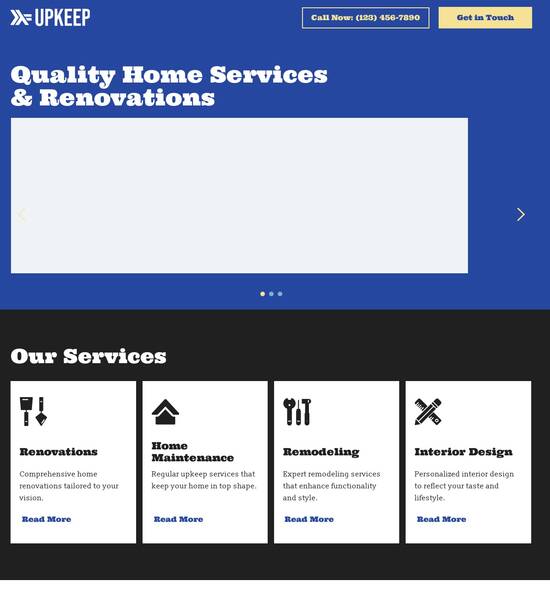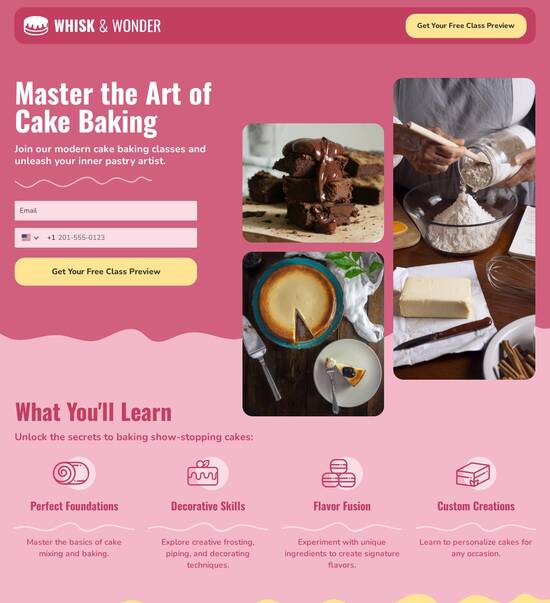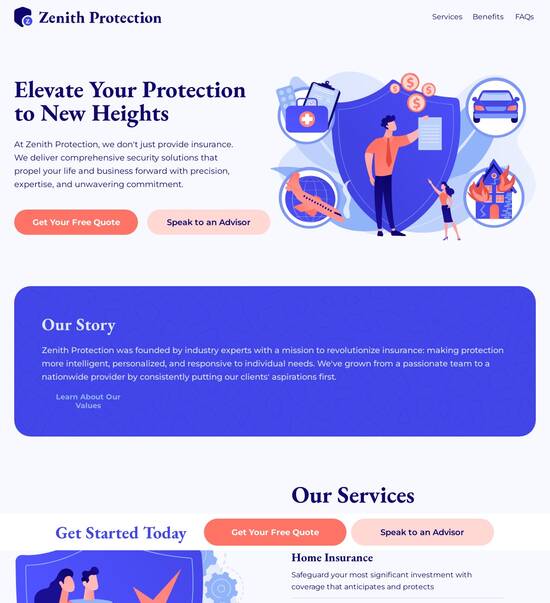
One page website template for Executive chefs
Explore Similar TemplatesAbout template
Achieve your online goals with the one page website template for Executive chefs.
Recommended templates

Easy to build without coding
With the intuitive drag-and-drop builder, anyone on your team can create high-converting pages without any knowledge of code or design. Make enhancements to your landing page with custom widgets using Javascript, HTML/CSS, or third-party scripts.

Multiple layouts for any industry and goal
Select from 500+ landing page layouts built to boost conversions across industry-specific scenarios. Customize them by adjusting fonts, adding images, and generating on-brand content with the AI assistant. Quickly scale with Instablocks® and Global Blocks that you can save, reuse, and update globally.

Loads fast and looks polished on any device
Every template is responsive, which means they present professionally on any device and load blazingly fast with our Thor Render Engine. You can also power them up with Google AMP technology to deliver an unparalleled mobile experience and drive higher conversions.

Robust analytics & experimentation
Get real-time updates and reporting across all your devices, showing the number of visitors, conversions, cost-per-visitor, and cost-per-lead. Launch AI-powered experiments, run A/B tests, and use heatmaps to analyze user behavior, then optimize your landing page to maximize conversions.







Easy to build without coding
With the intuitive drag-and-drop builder, anyone on your team can create high-converting pages without any knowledge of code or design. Make enhancements to your landing page with custom widgets using Javascript, HTML/CSS, or third-party scripts.
Multiple layouts for any industry and goal
Select from 500+ landing page layouts built to boost conversions across industry-specific scenarios. Customize them by adjusting fonts, adding images, and generating on-brand content with the AI assistant. Quickly scale with Instablocks® and Global Blocks that you can save, reuse, and update globally.
Loads fast and looks polished on any device
Every template is responsive, which means they present professionally on any device and load blazingly fast with our Thor Render Engine.
Robust analytics & experimentation
Get real-time updates and reporting across all your devices, showing the number of visitors, conversions, cost-per-visitor, and cost-per-lead. Launch AI-powered experiments, run A/B tests, and use heatmaps to analyze user behavior, then optimize your landing page to maximize conversions.
All the features you need to build lead-generating landing pages
Explore more featuresLearn how to build top-performing landing pages for any goal
FAQs
Leading the way in building high-performing landing pages





Unlock the power of instapage for your digital marketing campaigns
Instapage serves as the most powerful landing page and conversion rate optimization (CRO) platform designed specifically for marketers aiming to optimize the ROI of their digital campaigns. Whether you work in business services, the tech sector, or education, Instapage allows for a seamless and efficient page creation process that requires no coding skills.
How to create stunning landing pages using instapage
Creating effective landing pages with Instapage involves a few essential steps that maximize the platform’s capabilities. Start by selecting one of the 100+ customizable templates that align with your campaign goals. Utilize the intuitive drag-and-drop builder to add elements like images, testimonials, and lead capture forms.
- Choose the right template: Selecting a conversion-focused layout can significantly impact lead generation.
- Utilize Instablocks: These reusable sections enhance efficiency, allowing you to maintain consistency across pages without starting from scratch.
- Incorporate lead generation elements: Use built-in features to engage visitors, such as forms and calls to action.
Optimizing landing pages for success
Once your landing page is set up, the next step is to optimize it for higher conversions. This begins with understanding user behavior through heatmaps and A/B testing.
- Use heatmaps: Analyze where users are clicking and how they interact with your content to make informed adjustments.
- Conduct A/B tests: Test variations of your landing page to determine which elements perform best in converting visitors into leads.
- Implement personalized experiences: Deliver dynamic content that speaks to the specific preferences and needs of different audience segments.
Collaborating and refining your landing pages
A significant advantage of Instapage is the ability to collaborate with your team in real-time. This ensures swift revisions and seamless final approvals.
- Share pages securely: Instapage enables you to share your landing page drafts with stakeholders for feedback.
- Leave instant feedback: Collaborators can leave notes and comments directly on the page, streamlining the review process.
- Edit in real-time: Make changes on the fly, ensuring your team is always aligned and up-to-date.
With these steps, marketers can effectively harness Instapage to enhance their campaigns and drive ROI.
Ready to elevate your digital marketing strategy? Start using Instapage today and experience the transformation.
Sign up for a free trial now to explore the powerful features of Instapage and see how it can accelerate your marketing efforts!
People also ask about One page website template for Executive chefs
One page website template for executive chefs
Crafting culinary narratives: The unique value of a one page website
For executive chefs, establishing an online presence is as crucial as perfecting a signature dish. A one page website serves as a digital culinary portfolio that succinctly defines your brand and showcases your artistry in the kitchen. This single-page format allows chefs to distill their culinary identity into a visually appealing and easy-to-navigate site, enabling prospective clients and customers to connect with their unique culinary brand without overwhelming details.
Defining your culinary brand requires a keen focus on personal identity and visual aesthetics. The website's design elements — from colors to typography — should authentically reflect your culinary philosophy and style. For instance, a chef specializing in rustic farm-to-table cuisine may opt for earthy tones and warm, inviting images, while a pastry chef might choose whimsical colors and elegant fonts to evoke a sense of sophistication and delight.
Simplicity plays a vital role in visual storytelling. A minimalist approach enhances user engagement by allowing visitors to absorb content without distraction. This means streamlined navigation is essential; a well-structured one page website guides users naturally through information, making it easy to learn about the chef, view the menu, or read testimonials in a seamless manner.
Core features of the one page template
An effective one page website for executive chefs should feature responsive design that ensures compatibility across devices. With more users browsing on their smartphones or tablets, a fluid grid system optimizes viewing regardless of screen size. This adaptability not only enhances user experience but also encourages potential clients to explore various aspects of the chef’s offerings without hassle.
The hero section captures attention through striking imagery — the heart and soul of culinary presentation. Chef websites should employ high-quality photographs that introduce signature dishes or memorable dining experiences. Techniques such as parallax scrolling and captivating backgrounds can further amplify the impact of this opening visual, giving a lasting impression that encourages visitors to scroll for more information.
Essential elements: What every executive chef should include
The 'About the Chef' section is one of the most personal touches on a chef’s website. This area should highlight the chef’s professional background, previous culinary experiences, and cooking philosophy. A storytelling approach can add depth to the chef’s bio, helping visitors to understand their journey and connect on a personal level. Sharing anecdotes or memorable milestones in one’s culinary career can transform a simple biography into an engaging narrative.
Menu highlights are crucial for enticing visitors and showcasing the chef's expertise. Presenting a distilled menu alongside vivid images offers a tantalizing glimpse into the offerings. Integrating seasonal specials means the content remains fresh and relevant, encouraging regular visits from enthusiasts eager to try new creations.
Interactive features to involve and inspire
Interactive features can significantly enhance customer engagement on a chef’s website. Embedded contact forms facilitate inquiries, reservations, and feedback, creating an open channel of communication. Providing dynamic fields that might ask visitors for their preferred dining experience or occasion can personalize interactions, making guests feel valued and connected to the chef.
Social proof in the form of testimonials allows chefs to showcase positive dining experiences. Integrating visual elements—like star ratings and customer review snippets—adds credibility. A dedicated section for testimonials can subtly encourage potential clients to explore the chef’s offerings, knowing others have positively experienced the cuisine.
Implementing modern web technologies: A seamless user experience
Incorporating modern web technologies pays off by ensuring a smooth user experience. Using `document.addeventlistener` can help create engaging elements that respond dynamically when the user interacts with them. For instance, hover effects on images or animated menus can draw attention and enhance usability, making the website feel alive and responsive.
The `DOMContentLoaded` event is essential for optimizing page performance. It indicates when the HTML document has been completely loaded and parsed, allowing JavaScript execution to begin without blocking the initial rendering. By delaying certain scripts until this event, chefs can ensure faster load times, keeping visitors engaged from the moment they arrive.
SEO optimization strategies for maximum visibility
One of the critical components of a successful website is optimization for search engines. Identifying and integrating relevant keywords into the culinary content is essential. This means placing significant phrases within headings, meta descriptions, and across body text strategically to improve searchability. Consider terms relevant to your specialty, such as 'fine dining executive chef' or 'seasonal gourmet cuisine.'
Moreover, leveraging local SEO can greatly enhance visibility for prospective customers in the area. Optimizing the website for local search involves utilizing location-specific keywords and integrating Google My Business features. This ensures the brand appears in local searches, attracting clientele looking for nearby dining experiences tailored to their tastes.
Showcasing culinary expertise through visual and multimedia elements
High-quality imagery is vital in stunning culinary digital presentations. Selecting images that not only showcase dishes beautifully but also represent the brand's image is crucial. Chefs should format these images properly and optimize them for fast loading speeds, ensuring that aesthetic appeal does not come at the cost of site performance.
Video content offers a dynamic addition to websites, allowing chefs to engage visitors through recipe demonstrations or behind-the-scenes action. Incorporating video segments can dramatically enhance the experience, making potential customers feel like they are part of the culinary journey. Adopting best practices for video embedding—ensuring reduced load time and maintaining site speed—is key for a balanced experience.
Analytics and performance evaluation
Tracking visitor behavior on a website is crucial for ongoing improvement. By utilizing tools like Google Analytics, chefs can monitor how visitors interact with the site. Key performance indicators include the number of visitors, engagement rate, and conversion metrics which provide insights into the site's effectiveness. Understanding these metrics allows chefs to adjust content and design according to their audience's preferences.
Continuous improvement based on data insights can significantly enhance a chef's online presence. Employing A/B testing allows chefs to experiment with various layouts and calls to action, making data-driven decisions that can improve user engagement. Regular revisions based on analytical feedback foster growth and success, ensuring the site remains relevant and appealing to visitors.
Security and maintenance considerations
Maintaining a secure website is essential for protecting the digital presence of executive chefs. Regular updates and backups are vital methodologies for safeguarding content against potential threats. Online tools can automate these backups, ensuring the site can be restored smoothly in case of any issues. Ensuring the website is up-to-date with safety protocols is part of a chef's responsibility in managing their digital assets.
Furthermore, compliance with legal requirements and making the website accessible are critical. Chefs should navigate food-related legalities ensuring their promotions and services respect industry standards. Implementing accessibility features allows the website to cater to all audiences, enabling an inclusive dining experience that resonates with a broader clientele.
Future trends: Evolving the executive chef's online presence
As technology continues to advance, executive chefs must stay ahead of the curve regarding their online presence. The integration of artificial intelligence and chatbots into websites can enhance customer service by providing immediate responses to common inquiries. This could include handling reservations or providing menu details, making it easier for patrons to engage with the chef’s offerings.
Another emerging trend is the rise of virtual culinary experiences. Chefs can capitalize on the demand for online cooking classes and culinary demonstrations by integrating e-commerce features for culinary product sales. Expanding the website's functionality to include virtual events offers chefs an innovative way to reach and inspire an audience beyond traditional dining experiences.
Personalizing the user journey: Customization options available
Customization options on a one page website template empower chefs to create a unique online experience. Adjusting icon adaptations can effectively resonate with different cuisines; for instance, a chef focusing on Italian cuisine may choose icons reflecting Mediterranean aesthetics. Furthermore, the ability to tailor color schemes ensures visual consistency that aligns with the culinary offerings presented.
Adding personality through unique content sections can enhance the website's richness. Including a blog dedicated to sharing recipes, culinary tips, and experiences creates an engaging environment for visitors to return to regularly. Additionally, creating space for upcoming events and cooking workshops invites interaction, fostering community and establishing the chef as an authority in the culinary world.
Ready to skyrocket conversions?
Supercharge your ad campaigns with high-performing landing pages
Get started














